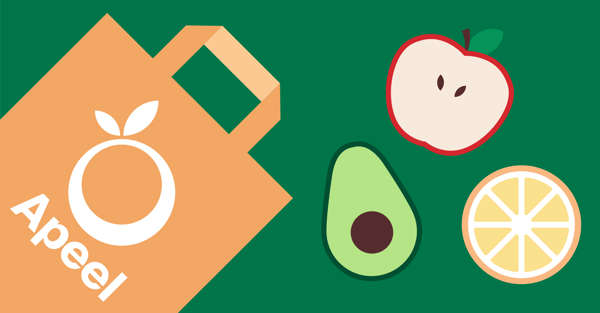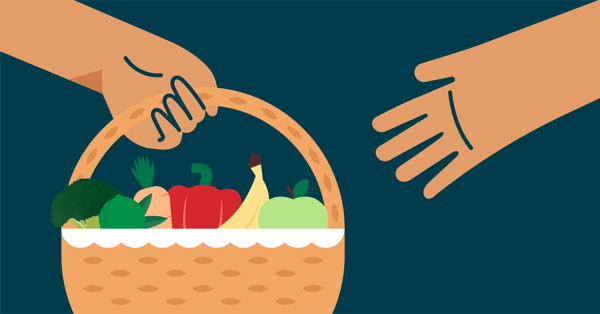In 1970, the first Earth Day took place here in Apeel’s hometown of Santa Barbara. It started with a focus on the visible issues affecting our planet— oil spills, pollution, etc. Over the last few decades, the conversation has shifted to a somewhat invisible enemy: climate change. And this year, we find ourselves facing an unprecedented issue: a global pandemic known as COVID-19.
As a company, we believe in finding real solutions to complex problems like these. We were built to fight food waste and feed the future. And now, given everything we face during these times of COVID-19, we realize our mission has become more urgent than ever. Not only that, it’s also become a big focus in the larger conversation. Project Drawdown recently came out with the study that reducing food waste is actually the #1 solution to fighting climate change.
This year, Earth Day isn’t so much an external celebration as it is an internal action. Because we’re not driving our cars, emissions are down. We’re seeing inspiring photos from all around the world proving the drastic reduction in air pollution because we’re all staying home. But because of this same fact, food waste is up. There’s a longer term silver lining in all of this: We also now have tangible proof of how much of an effect each of us has when we work toward a common solution. As we celebrate 50 years of Earth Day, we want to offer some ideas and actions we can all take right now. Together, we can #FightFoodWaste. And best of all? We can start right here at home.
But first: Why #FightFoodWaste?
For those who aren’t familiar with the effects of food waste on climate change, it’s a fair question. To prioritize this most pressing issue of food waste, we first have to understand it. Here, from a previous blog post, we can see what’s at play:
“In the U.S., food waste is the largest source of municipal solid waste in landfills, contributing more than 50 million tons each year. Imagine the waste of resources, energy, and money used to grow, process and distribute this food that was ultimately thrown away. It requires nearly 780 million pounds of pesticides and 4.2 trillion gallons of water each year on roughly 30 million acres of cropland to grow food that is eventually sent to landfills. These startling inefficiencies in our global food system also result in 8% of global greenhouse gas emissions, making food waste a significant contributor to climate change.”
We know that cutting food waste is actually the number one way scientists and researchers say we can fight climate change (source: Project Drawdown), because avoided waste means tremendous resource savings throughout the supply chain–from energy to water–and the avoidance of harmful methane gas emissions from landfill waste. It’s impact with a multiplier.
So how can I #FightFoodWaste?
If there’s anything you take away, let it be this: The biggest impact you can make actually starts right at home. Think about it this way: Wasting one piece of food in our own kitchens is much more impactful than letting the same piece of food go to waste at the farm. As food moves throughout the supply chain, more resources are utilized and the emissions are increased. (Suddenly, those extra avocados you bought seem all the more precious, right?)
Since most of us are sheltering in place at home for the foreseeable future, these changes in consumption are something we can focus on right now. Why not use this time to make a huge difference in our own home cooking routines?
We’re sharing simple ways you can address food waste on an individual level.
And that, of course, starts with Apeel produce.

Buy food that lasts longer
Especially when we’re all trying to do a bit less grocery shopping to avoid being out, purchasing produce that will last an extra one or two weeks is a game-changer. Apeel avocados, limes, apples, and mandarins give you more time to use what you have and still enjoy fresh, crisp, nutrient-packed produce. (Not to mention that produce comes at the same price as regular produce.)
So where can you get Apeel produce? (We love that question.)
Here’s where you can locate current stores where Apeel is sold: https://apeelsciences.com/find-us/

Make food last longer
It’s not just about what you buy, it’s also what you do with those fruits and veggies. In other words, making the most of your homemade meals makes a big difference. We’ve covered some great tips on previous blog posts to help you do just that, so we wanted to share some of those highlights here:
Keep produce fresh by keeping them separate
Did you know that some fruits and veggies shouldn't be stored near each other because they’ll ripen (and deteriorate) faster? Turns out, social distancing among your avocados and, say, those cucumbers or carrots can be helpful too.
Understand what expiration dates mean
In many cases, food that is perfectly safe to consume is thrown out because of the date on its label. Many people don’t realize these dates are simply indications of when a product’s quality (e.g., taste, texture, color) can no longer be guaranteed. So how can you tell if something is safe to eat? We’re sharing a few ways to know better than those printed-on dates.
Create a system to keep track of what you have in stock. Rules like “first in first out” help in making sure you keep anything that needs to be eaten first top of mind and in full view. Push new items to the back and pull forward the foods that need to be eaten soonest. Take inventory often to see what you have hiding in corners and bottom of drawers—you may discover some non-perishables or canned goods that you’ll never eat, which can then be donated to local food banks in need.
What better time than now to figure out innovative ways to repurpose the food items you previously tossed as waste? Since we’re all doing more home cooking than ever, it’s a perfect time to rethink recipes that don’t use every part of an ingredient. Peels, seeds, rinds, tops, stalks, and bones, for instance: these can be used for another recipe. Pumpkin seeds? Roast them into crunchy snacks. Kale stems that seem too tough for your salad? Freeze ‘em and add them to a future smoothie. If you get creative, the possibilities become endlessly rewarding.

What’s being done to #FightFoodWaste during COVID-19?
With restaurants, schools, and large hotels closed, the food waste issue has become exponentially greater than it was just months ago. Many of the nation’s largest farms don’t have anywhere to send their crops, and are having to destroy millions of pounds of food that they can no longer sell. This New York Times article does a great job of explaining the issue.
“The amount of waste is staggering. The nation’s largest dairy cooperative, Dairy Farmers of America, estimates that farmers are dumping as many as 3.7 million gallons of milk each day. A single chicken processor is smashing 750,000 unhatched eggs every week. Many farmers say they have donated part of the surplus to food banks and Meals on Wheels programs…. But there is only so much perishable food that charities with limited numbers of refrigerators and volunteers can absorb. And the costs of harvesting, processing and then transporting produce and milk to food banks or other areas of need would put further financial strain on farms that have seen half of their paying customers disappear.”
But before you feel overcome with doom and gloom, know there’s a whole new crop of promising non-profits currently addressing these urgent issues. As recently as last week, the USDA announced a Coronavirus Food Assistance Program.
“USDA will partner with regional and local distributors...to purchase $3 billion in fresh produce, dairy, and meat. We will begin with the procurement of an estimated $100 million per month in fresh fruits and vegetables, $100 million per month in a variety of dairy products, and $100 million per month in meat products. The distributors and wholesalers will then provide a pre-approved box of fresh produce, dairy, and meat products to food banks, community and faith based organizations, and other non-profits serving Americans in need.”
And, of course, there are more ways you can help.
For one, Feeding America is currently supporting 200 food banks and 60,000 food pantries and meal delivery services by connecting food producers and distributors with surplus food in the food bank network. You can contribute to their efforts by giving money directly or donating food to your local food bank.
We’re calling it: This year, the best way to honor Earth Day is by joining the growing movement to reduce food waste. That initiative, luckily, starts at home. And then? Maybe head out to Twitter and share with others what’s working best for you. We’ll be sharing some of our own at @ApeelSciences with #FightFoodWaste.
What has remained true since that first Earth Day in 1970 is that we’re all in this together. Now maybe more than ever. Let’s find ways for us all to do our small part in the larger cause.

